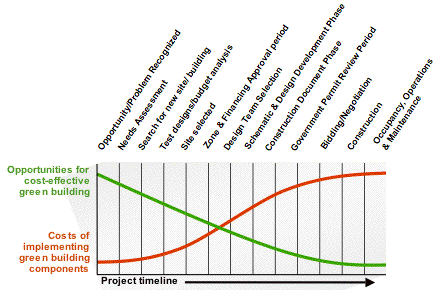Decisions, decisions
To build a truly green building--- one that pays off for residents, the environment, and your pocketbook--you must make a commitment to green before the first sketches are drawn. Look for professionals with experience in green design and construction when choosing your architect, your engineer, and your contractors. Keep green in mind when you visit the site and start to talk about design. Incorporating green from the very beginning gives you opportunities to think big, evaluate the options, and make the decisions that will deliver an efficient, healthy, attractive building within your budget. Conversely, adding green features after the design is complete will add costs and create complications.
Integrated Design Timeframe Cost Effectiveness
Early goal setting fosters integrated design solutions
Early green decisions = lower implementation costs

Which green?
The first step for you and your team is to identify green goals. Standards require certain levels of energy efficiency and site density, but you might prioritize indoor air quality to give residents healthy homes, not just low utility bills. These decisions will depend in part on the expertise available. They should, however, reflect community and resident needs. Minimizing stormwater runoff, for example, is an environmental priority for the Washington, DC area.
Light green or deep green?
The next decision is a difficult one: how green do you make your building? The answer will emerge as your team works through the first stage of the integrated design process. Energy modeling software will help determine how well the site is suited for daylighting, passive solar heating, and natural ventilation, and thus the potential for energy savings. For rehab, building envelope and equipment conditions provide a starting point for your decisions: how will investments in replacement influence life-cycle costs for individual components and systems, as well as for the whole building? An architect or consultant can help identify other cost-effective approaches and can then work with your team to weave green goals into your design and budget.
Details and materials require research
Each component that you inject with green will affect several other building systems. Making these decisions early gives your team time to adjust the design, especially because green approaches, technologies, and materials are unfamiliar to many architects, engineers, and contractors. Much of the incremental cost of a green building comes from the added homework required here to realize savings in construction. For example, once an engineer researches structurally insulated panels, he or she can recalculate insulation needs. The subcontractor can submit revised labor estimates and waste disposal charges. You may find that an investment in training for a specific contractor will more than pay for itself, or, alternatively, that certain materials are too expensive. Life-cycle cost assessment is one tool that will help you make many of these decisions.

